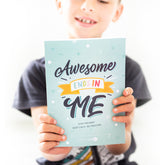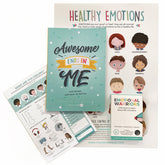Helping Your Child Navigate Anxiety: Practical Strategies for Parents
Watching your child struggle with anxiety is tough, and as parents, it’s tempting to try to make it go away.
But instead of focusing on “fixing” the issue, it’s far more empowering to equip our kids with the tools they need to manage their anxiety themselves. Here are some practical approaches to help guide your child through their worries and build emotional resilience.
Normalise Their Emotions
We all want our kids to feel happy and carefree, but it’s equally important to show them that it’s okay to experience the full range of emotions, including fear, frustration, and sadness. Let your child know that having strong feelings isn’t something to be ashamed of — it’s part of being human. By reassuring them that all emotions are valid, you’re teaching them that they don’t need to hide their struggles or pretend to be okay when they’re not.
This is where the Resilient Kids Toolkit can come in handy. It includes the Resilient ME Gratitude Journal for Kids, which helps children express their emotions through gratitude practices, and the Emotional Warriors Feelings Notepad, designed to encourage reflection and mindfulness. These resources give children a safe space to acknowledge and explore their feelings, empowering them to better understand what they’re going through.
Be a Role Model for Healthy Coping
Children learn by watching us, even when we don’t realise it. The way you handle stress and anxiety teaches your child how to respond to their own challenges. Show them that it’s okay to feel anxious, but also demonstrate healthy ways to cope. For example, you might say, “I’m feeling really nervous about a meeting today, so I’m going to take a few deep breaths and write down what I need to focus on.”
By sharing your coping strategies out loud, you’re modeling resilience. The Resilient Kids Toolkit supports this idea, offering fun, hands-on tools like the Emotional Warriors Card Game, which teaches children to identify and manage their emotions through play, helping them learn different ways to stay calm and focused.
Create Space for Conversations
It can be difficult for children to talk about their worries, especially when they don’t fully understand what’s going on themselves. To make these conversations easier, try engaging them in relaxed, side-by-side activities like drawing or walking, which can feel less intimidating than face-to-face talks. The important thing is to listen without judgment and make sure they know you’re there when they’re ready to open up.
If your child is reluctant to talk, don’t push it. Let them know that their feelings are welcome whenever they feel comfortable sharing. In the meantime, they might benefit from journaling. The Resilient ME Gratitude Journal for Kids is designed to encourage kids to express their thoughts, emotions, and daily experiences, helping them build self-awareness and emotional resilience.
Offer Calming Tools and Strategies
When anxiety strikes, having a go-to toolkit of calming strategies can make a world of difference. Encourage your child to try out different techniques like deep breathing, stretching, or practicing gratitude. You can even make a list together of things they can do when they start feeling overwhelmed. Visual reminders can be really helpful, too.
The Resilient Kids Toolkit is packed with resources to help your child stay grounded in stressful moments. The Healthy Emotions Printable Poster, which comes as a free gift with the bundle, offers a colorful, easy-to-follow guide for identifying emotions and choosing coping strategies. And don’t forget the Emotional Warriors Feelings Notepad — a great space for your child to communicate and acknowledge their feelings whenthey feel overwhelmed.
Keep the Basics in Check
It’s easy to overlook how much physical well-being impacts emotional health, but making sure your child gets enough sleep, eats well, and stays active can greatly reduce anxiety. Bodies that are tired or hungry are more likely to feel stressed. Maintaining a regular routine with meals, sleep, and exercise sends a reassuring signal to the brain that everything is okay.
Stress hormones like cortisol can spike when these basic needs aren’t met, making it harder for your child to cope with anxious feelings. Keeping their body in balance can help keep their mind calm, too.
Face Fears, Don’t Avoid Them
As parents, we often want to protect our kids from anything that might cause them distress. But when it comes to anxiety, avoiding the things that trigger it can actually make their world smaller and their anxiety worse. Instead, encourage your child to face their fears, one step at a time. Whether it’s trying a new activity, meeting new people, or tackling a challenge at school, support them in gently pushing their boundaries.
Using the tools in the Resilient Kids Toolkit can make this process easier. The Resilient ME Gratitude Journal for Kids helps children focus on their strengths and what they’re grateful for, reinforcing a positive mindset. The Emotional Warriors Card Game offers a fun, interactive way to explore different ways of handling stressful situations, boosting their confidence in facing fears.
Teach Tolerance of Anxiety
One of the most important skills children can learn is how to tolerate anxious feelings, rather than avoid them. Anxiety is a natural response to challenges, and the more kids practice navigating these feelings, the better equipped they’ll be to manage stress in the future. Help your child reframe their anxiety as a sign that they’re growing and learning. The more they experience that they can cope with anxiety, the less power it will hold over them.
Problem-Solve Together
When your child is feeling anxious about something specific, like an upcoming test or a school trip, it can help to work through the problem together. Ask them what’s worrying them, and brainstorm solutions as a team. This approach not only helps ease their anxiety but also builds their problem-solving skills and resilience.
Encourage your child to write down their worries and possible solutions in their journal, giving them a sense of control over the situation. Reflecting together on how they overcame a challenge can also boost their confidence in handling future situations.
---














